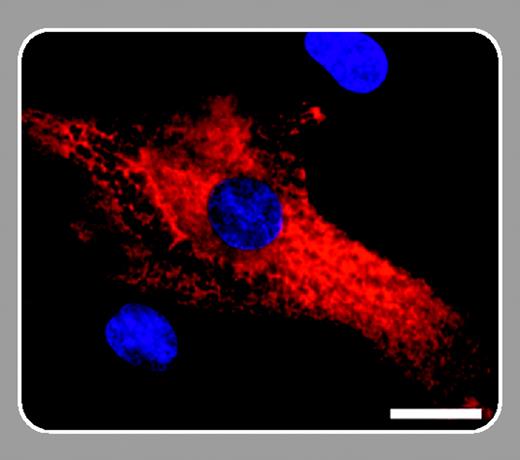HEMOSTASIS, THROMBOSIS, AND VASCULAR BIOLOGY
Although various growth factors can support angiogenesis, the vascular endothelial growth factor (VEGF) and angiopoietin families are relatively specific. Both bind to receptors on endothelial cells.
The VEGF family consists of 6 ligands: placental growth factor (PLGF), VEGF (or VEGF A), and VEGF B, C, D, and E, which bind to 3 receptor tyrosine kinases (VEGFR-1/Fms-like tyrosine kinase-1 [flt-1], VEGFR-2/fetal liver kinase-1 [FLK-1]/kinase domain–containing receptor [KDR], and VEGFR-3/flt-4) as well as a neuropilin (NRP1) coreceptor. VEGF acts early in angiogenesis by inducing endothelial growth and tube formation by invading collagen as well as acting as a potent permeability factor. VEGF is made and found in fibroblasts and most tumor cells.
A second family exerting an important role in vascular development and stabilization has been identified and designated angiopoietins (Ang's). Ang's regulate angiogenesis by activating (Ang-1) or blocking (Ang-2) a surface receptor tyrosine kinase restricted to endothelial cells, Tie-2/Tek. Ang-1 helps to maintain vascular integrity and is involved in vessel maturation. It induces migration and sprouting of endothelial cells and is an antipermeability factor. Ang-1 is found in pericytes, periendothelial smooth muscle–like cells. Overexpression of Ang-1 in transgenic mice induces increased vascularization. In the absence of Ang-1, endothelial cells are poorly associated with the underlying matrix and do not properly recruit and associate with periendothelial supporting cells. Thus, Ang-1 appears to be involved in a later stage of vessel development.1-3
Ang-1 consists of 4 alternatively spliced isoforms: 1.5 kb, 1.3 kb, 0.9 kb, and 0.7 kb. The dominant 1.5-kb isoform activates Tie-2 by inducing phosphorylation. The structures of the 1.3- and 0.9-kb isoforms are consistent with dominant-negative regulatory molecules.4 A better studied regulatory molecule, Ang-2, acts predominantly as an antagonist of the Ang-1/Tie-2 receptor by binding the receptor but not phosphorylating it. Ang-2 is expressed in areas undergoing vascular remodeling and is involved in neoangiogenesis.5 By binding to Tie-2, Ang-2 leads to decreased vessel maturation and either vessel regression (in the absence of VEGF) or enhanced vessel sprouting in the presence of VEGF. It has been suggested that vascular remodeling requires a form of plasticity in which regression is required for Ang-1–induced vessel sprouting. Ang-2 is made and selectively expressed in endothelial cells. Overexpression of Ang-2 in transgenic mice is embryonically lethal and similar to the null Ang-1 and Tie-2 phenotypes, supporting an antagonist role for Ang-1 and Ang-2 with their receptor.
In this issue, Fiedler and colleagues (page 4150) confirm the presence, synthesis, and secretion of Ang-2 in endothelial cells but goes one step further. They have noted its storage in Weibel-Palade bodies in association with known Weibel-Palade storage proteins: von Willebrand Factor (VWF) and P-selectin. The rapid release of Ang-2 from endothelial cells with physiologic agonists such as histamine and thrombin makes a good case for its being a potent autocrine vascular growth factor, which may play an important role in maintaining vascular homeostasis during injury to the vascular bed.
Of further interest is Fiedler et al's intriguing observation that Ang-2 and P-selectin are within different compartments of Weibel-Palade bodies, suggesting a more complicated organization of these bodies; perhaps one is involved in transport and the other in storage. For example, they have shown that VWF appears to be required for the tracking of Ang-2 into Weibel-Palade bodies. Thus, a new Weibel-Palade storage factor has been discovered. The role of Weibel-Palade storage and secretion of Ang-2 is likely to play an important role in blood vessel repair.


This feature is available to Subscribers Only
Sign In or Create an Account Close Modal